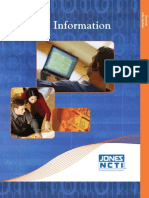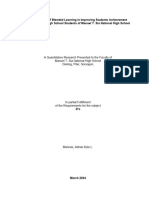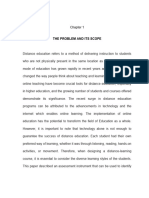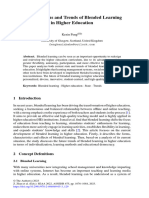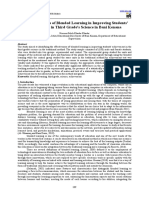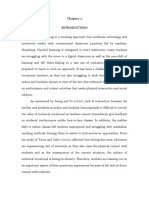Imradpaper
Imradpaper
Uploaded by
jacquelinesimon1234Copyright:
Available Formats
Imradpaper
Imradpaper
Uploaded by
jacquelinesimon1234Original Title
Copyright
Available Formats
Share this document
Did you find this document useful?
Is this content inappropriate?
Copyright:
Available Formats
Imradpaper
Imradpaper
Uploaded by
jacquelinesimon1234Copyright:
Available Formats
INTRODUCTION include the use of digital
technologies and new
The field of education is continually communication channels, such as
evolving, driven by technological social media – experienced a boom
advancements and the demand for during the COVID-19 pandemic that
innovative teaching methods that has impacted the whole educational
effectively engage students. One community. According to Malik,
notable development is the Heyman-Schrum, & Johri, (2019),
integration of blended learning, a Social media platforms and
pedagogical model that combines applications have become widely
traditional in-person classroom popular across all industries, for a
instruction with online learning variety of purposes. In university
resources. This chapter introduces a environment, however, integration of
research study that focuses on the social media either in the teaching-
impact of blended learning on grade learning process or as a
6 students of Esperanza Elementary communication tool to connect with
School, a topic that has gained stakeholders, happens rather slowly
newfound importance due to the compared to the wider industry
COVID-19 pandemic. As the benchmarks (O’Boyle, 2014).
pandemic disrupted traditional Blended learning is one of the
classroom learning, educators learning methods that combines
worldwide turned to blended learning face-to-face learning in the
as a resilient and adaptable solution. classroom and online learning that
Blended learning, once considered uses electronic media. Blended
innovative, has now become an learning can Improve students’
essential tool for maintaining engagement in learning, and it also
education continuity in challenging helps students achieve a meaningful
times. This approach seamlessly Level of learning (Innes & Wilton,
combines in-person and online 2018). That is because blended
instruction, ensuring both access to learning provides Several features:
educational content and students’ social interactions, technology
health and safety. In doing so, quality, and face to face support
blended learning not only bridged the (Tawil, 2018). Therefore, blended
physical gaps created by the learning can complement a
pandemic but also revolutionized conventional teaching and learning
education delivery, emphasizing Process that lasts only a few hours
flexibility and adaptability. According in school. According to Sulisworo et
to Hesse (2017). Blended learning is al. (2018), flexible learning
used to incorporate technology into opportunities in blended Learning
the classroom and to aid in can improve students’ writing skills.
instruction. Technology has opened Students can access the material
the path for many educational anywhere and anytime through the
reforms and innovations (Tayag, internet and can discuss without time
2020). For instance, the Internet has limits through blended Learning.
reshaped the way students, teachers Based on previous research on the
and universities interact (Scott & blended learning method conducted
Stanway, 2015), enabling the by Qindah (2018), It was found that
emergence of new learning models, blended learning had a positive
such as online learning, which, since impact on students’ Grammar
the beginning of the century, started scores. Furthermore, Qindah (2018)
to experience high growth also suggested that other
(Goodyear, Salmon, Spector, researchers Examine the effects of
Steeples, & Tickner, 2001). The blended learning methods on
expansion of these new pedagogies different language skills such as
in the educational field – which
Writing. Related to this issue, a study is critical, schools must be intentional
about students’ perceptions of the with blended learning integration. As
blended learning Method was also Tucker et al. (2017) noted, “starting
conducted by Cakrawati (2017). The with the why and not the what is
result of the study showed that Most key”. Preparing students for a future
of the students gave positive that has boundless possibilities is
responses to the use of a blended daunting, but if educators see they
learning method. The students also value in it, its effectiveness grows.
said that the online platform in Therefore, if educators see the
blended learning activities already necessity for building strong 21st-
helped Them in practicing target century kills in students, they will
language, expands their knowledge understand the why behind the need
about vocabularies, and improving to implement blended learning. Also,
their understanding of the materials according to him, the schools that
being taught. This statement was are successful are the ones that are
also Supported by Ali and Sofa open to change, willing to evolve to
(2018) that stated most of the meet the needs of students, and are
students gave positive Perceptions not stuck in their ways of doing what
of the implementation of blended they have always done. Schools that
learning method because blended can reinvent themselves are the
learning Methods helped them ones that see success. Therefore, it
enhance their English language skills is crucial for educators to understand
and provided them with Interactive how blended learning works, how
exposure in the teaching and best to navigate, and how much time
learning process. Based on the should be dedicated to technology
background Above, research has enhanced learning. During class
been conducted to know how the versus a more traditional learning
implementation blended learning setting, so they can make necessary
Method on students’ writing changes to meet the needs of
competence in writing recount text students. Blended learning, a
and to know students’ Perceptions pedagogical approach that combines
after the implementation of blended traditional face-to-face instruction
learning method. Blended learning with online learning activities, has
lends itself to be an effective means gained prominence in the field of
to foster 21st-century skills in education over the past few
students. Twenty-first century skills decades. This innovative approach
are those skills necessary to seeks to harness the advantages of
successfully navigate the both in-person and online learning,
environment in which they will be providing educators with a versatile
living. According to Hallerman, tool to enhance student engagement
Lewis, & Dresbach (2019) and learning outcomes. The ever-
“Educators should be inspiring evolving landscape of technology
creativity, encouraging collaboration, and educational theory has
expecting and rewarding critical catalyzed the evolution of blended
thinking, and teaching children not learning, making it a subject of
only how to communicate, but also extensive research and discussion.
the power of effective This research aims to explore the
communication.” Blended learning is multifaceted aspects of blended
the vessel to provide students with learning, including its various
skills and competencies they need to models, effectiveness, challenges,
thrive because it has the power to and implications for education. By
fully cultivate creativity, collaboration, delving into the intricacies of this
critical thinking, and communication. pedagogical approach, we can better
Building strong 21st-century learners understand its potential to reshape
the future of teaching and learning. time to test the learning experience
Also blended learning is an on various mobile devices. Some
educational approach that integrates students only used a mobile phone.
traditional in-person classroom However, some online activities and
teaching with online instruction and learning management system
digital resources. It combines face- experiences might not work as well
toface interaction with technology- or behave differently on a phone.
mediated activities, offering a flexible Teachers and students also needed
and personalized learning health and wellness support.
experience for students. This hybrid Teachers were expected to support
approach aims to enhance students, but many of them felt
engagement, cater to diverse anxiety and were stressed and
learning styles, and optimize the overwhelmed. To support students
benefits of both physical and virtual with severe technology challenges,
learning environments. This teachers could create a free Google
systematic review of the research Voice phone number and allow
literature on online and blended students to read aloud their
learning from schools starts by handwritten work as a voicemail
outlining recent perspectives on message. Some students managed
emergency remote learning, as the transition to remote learning
occurred during the Covid-19 quickly, or had previous experience
pandemic. We give aims for the taking online courses, and these
study and explore the original students could be encouraged to be
contribution of this paper. However, peer mentors and provide support for
much of the literature then reviewed other students. The boundaries and
relates to the period before the methods of learning and teaching
pandemic, with implications for have been broadened along with the
action after the pandemic. According increasing popularity of the Internet
to (Feenberg, 2019). Technology is and the rapid development of
not just digital, it is also social and network technology (Cheng & Chau,
political, shaping and being shaped 2016), in that, online education has
by changing social practices. The been growing rapidly. Since both
pandemic increased the speed of online education and traditional face-
growth of technology, but this review to-face teaching method have their
is also about how teachers come to own advantages, it is necessary to
engage with and implement combine the advantages of both
technology, especially outside of teaching forms and test the
school, which involves many effectiveness of the blended learning
adaptations and processes beyond approach (Bailey & Morais, 2005).
the technology itself. Post-pandemic Playfulness, usefulness, and
we hope to return to a calmer and interaction of the blended learning
more orderly state, but with a larger platform have a positive impact on
number of teachers much more cognitive engagement. In other
experienced (and hopefully words, when students perceive the
energized) in digital interventions blended learning platform as
outside school. Students and effective, playfulness and helpful for
families had contended with the interaction, they are more inclined to
availability of technology (e.g., accept the platform and participate in
sharing a limited number of devices the course learning, which is
while isolating with their family), consistent with previous studies
ethical issues (e.g., Zoom privacy), (Chen & Yao, 2016; Manwaring et
and personal issues (e.g., taking al., 2017). The teaching and learning
care of loved ones or not being able environment are embracing several
to do so). Teachers needed to take innovations and some of these
involve the use of technology of a planning evaluation research
through blended learning. This (Guskey, 2000) to establish the
innovative pedagogical approach effectiveness of blended learning.
has been embraced rapidly though it Guskey (2000) noted that planning
goes through a process. The evaluation fits in well since it occurs
introduction of blended learning before the implementation of any
(combination of face-to-face and innovation as well as allowing
online teaching and learning) planners to determine the needs,
initiatives is part of these innovations considering participant
but its uptake, especially in the characteristics, analyzing contextual
developing world faces challenges matters, and gathering baseline
for it to be an effective innovation in information. This study is done in the
teaching and learning. Blended context of a plan to undertake
learning effectiveness has quite a innovative pedagogy involving use of
few underlying factors that pose a learning management system
challenges. One big challenge is (moodle) for the first time in teaching
about how users can successfully and learning in a Ugandan
use the technology and ensuring university. The learner
participants’ commitment given the characteristics/backgrounds being
individual learner characteristics and investigated for blended learning
encounters with technology effectiveness include self-regulation,
(Hofmann, 2014). Hofmann adds computer competence, workload
that users getting into difficulties with management, social and family
technology may result into support, attitude to blended learning,
abandoning the learning and gender, and age. We investigate the
eventual failure of technological blended learning design features of
applications. In a report by Oxford learner interactions, face-to-face
Group (2013), some learners (16%) support, learning management
had negative attitudes to blended system tools and technology quality
learning while 26% were concerned while the outcomes considered
that learners would not complete include satisfaction, performance,
study in blended learning. Learners intrinsic motivation, and knowledge
are important partners in any construction. Establishing the
learning process and therefore, their significant predictors of outcomes in
backgrounds and characteristics blended learning will help to inform
affect their ability to effectively carry planners of such learning
on with learning and being in environments to put in place
blended learning, the design tools to necessary groundwork preparations
be used may impinge on the for designing blended learning as an
effectiveness in their learning. This innovative pedagogical approach.
study tackles blended learning Kenney and Newcombe (2011) did
effectiveness which has been their comparison to establish
investigated in previous studies effectiveness in view of grades and
considering grades, course found that blended learning had
completion, retentionretention, and higher average score than the non-
graduation rates but no studies blended learning environment.
regarding effectiveness in view of Garrison and Kanuka (2004)
learner characteristics/background, examined the transformative
design features and outcomes have potential of blended learning and
been done in the Ugandan university reported an increase in course
context. No studies have also been completion rates, improved retention,
done on how the characteristics of and increased student satisfaction.
learners and design features are Comparisons between blended
predictors of outcomes in the context learning environments have been
done to establish the disparity STATEMENT OF THE PROBLEM:
between academic achievement,
grade dispersions and gender 1. What are the Effects of the
performance differences and no Blended Learning Modality on
significant differences were found Academic Performances of the
between the groups (Demirkol & Grade 6 Pupils of Esperanza
Kazu, 2014). However, blended Elementary School?
learning effectiveness may be 2. How do Grade 6 Pupils of
dependent on many other factors Esperanza Elementary School
and among them student Adjust the Implementation of
characteristics, design features and Blended Learning Modality?
learning outcomes. Research shows
that the failure of learners to 3. What may be Interventions
continue their online education in Implemented by the Esperanza
some cases has been due to family Elementary School to Address the
support or increased workload Needs of the Grade 6 Pupils?
leading to learner dropout (Park &
Choi, 2009) as well as little time for
study. Additionally, it is dependent METHODS AND PROCEDURE
on learner interactions with
instructors since failure to continue METHOD
with online learning is attributed to
The study uses descriptive method
this. In Greer, Hudson & Paugh’s
of research; this type of research
study as cited in Park and Choi
provides a detailed and accurate
(2009), family and peer support for
picture of the characteristics and
learners is important for success in
behaviors of a particular population
online and face-to-face learning.
or subject. By observing and
Support is needed for learners from
collecting data on a given topic,
all areas in web-based courses and
descriptive research helps
this may be from family, friends, co-
researchers gain a deeper
workers as well as peers in class.
understanding of a specific issue and
Greer, Hudson and Paugh further
provides valuable insights that can
noted that peer encouragement
inform future studies (Sirisilla, S.
assisted new learners in computer
2023), because the study seeks to
use and applications. The authors
describe, and explain phenomenon
also show that learners need time
by collecting information through
budgeting, appropriate technology
structured questions. A survey
tools and support from friends and
checklist will use wherein the
family in web-based courses. Peer
respondents will provide the
support is required by learners who
information of what is being asked
have no or little knowledge of
on the questionnaire prepared by the
technology, especially computers, to
researchers. Quantitative method of
help them overcome fears. Park and
research will also use to determine
Choi, (2009) showed that
the number of respondents who will
organizational support significantly
respond on the survey that will be
predicts learners’ stay and success
conducted. In terms of selection of
in online courses because employers
the respondents, researchers use
at times are willing to reduce
random sampling – a method of
learners’ workload during study as
choosing samples in which all the
well as supervisors showing that
members of the population are given
they are interested in job-related
an equal chance of being selected. It
learning for employees to advance
is an unbiased of selection as
and improve their skills.
samples are drawn by chance. There
are various ways of getting the
samples through the simple random procedure and the statistical
sampling but this study will only use treatment.
the fishbowl technique.
PROCEDURES
DATA ANALYSIS
The researchers prepare letters
addressed to the specific sections. A survey checklist will use wherein
Will also provide questionnaires the respondents will provide the
which are based on uses and effects information of what is being asked
of blended learning. Upon the on the questionnaire prepared by the
approval, researchers will distribute researchers. Quantitative method of
the survey questionnaires to the research will also use to determine
Grade 6 students. After answering, the number of respondents who will
researchers will be retrieving the respond on the survey that will be
questionnaires. The answers of the conducted. In terms of selection of
respondents to the questionnaires the respondents, researchers use
will be tallied, analyzed, and random sampling – a method of
interpreted. choosing samples in which all the
members of the population are given
an equal chance of being selected. It
is an unbiased of selection as
RESPONDENTS samples are drawn by chance. There
The key respondents of the study are various ways of getting the
must be the students in all sections samples through the simple random
of Grade 6 students at Esperanza sampling but this study will only use
Elementary School. The number of the fishbowl technique.
students were as follows: 30- 40,
Grade 6 students.
EHTICAL CONSIDERATION
INSTRUMENTS Before the data gathering, the
researcher will give a signed letter
The researchers will use
from the research instructor and the
questionnaires to arrive at the
dean, contained the goal of the study
conclusions. Questionnaires were
and the target respondents.
based on the effects of blended
learning on Grade 6 students of During the actual data gathering, the
Esperanza Elementary School which researchers will guide the
are formed into statements respondents and will accompany
enumerated in the questionnaires. them to fill out the survey checklist.
RESEARCH DESIGN AND
METHODOLOGY
This chapter includes the method
used to achieve the objectives of the
undertaking. This also consists of the
research design, respondents,
sources of data, research REFERENCE
instruments, the data gathering
Li, S. & Wang, W. (2022). Effect of blended learning on student performance in
K‐12 settings: A meta‐analysis. Journal of Computer Assisted Learning 38 (5),
1254-1272. https://onlinelibrary.wiley.com/doi/abs/10.1111/jcal.12696
Asarta, C. J., & Schmidt, J. (2020). The effects of online and blended experience
on outcomes in a blended learning environment. Internet and Higher Education,
44, 100708. https://doi.org/10.1016/j.iheduc.2019.100708
Topping, K. J., Douglas, W., Robertson, D. M., & Ferguson, N. (2022b).
Effectiveness of online and blended learning from schools: A systematic review.
Review of Education, 10(2). https://doi.org/10.1002/rev3.3353
Hesse, L. (n.d.). The effects of blended learning on K-12th grade students. UNI
ScholarWorks. https://scholarworks.uni.edu/grp/116
Alammary, A. (2019). Blended learning models for introductory programming
courses: A systematic review. PLOS ONE, 14(9), e0221765.
https://doi.org/10.1371/journal.pone.0221765
Villanueva, J. A. R., Redmond, P., Galligan, L., & Eacersall, D. (2023).
Investigating blended learning interactions in Philippine schools through the
community of inquiry framework. Asia Pacific Education Review.
https://doi.org/10.1007/s12564-023-09826-4
Alamri M. M. (2022). Investigating students’ adoption of MOOCs during COVID-
19 pandemic: Students’ academic self-efficacy, learning engagement, and
learning persistence. Sustainability 14:714. 10.3390/su14020714
https://www.mdpi.com/2071- 1050/14/2/714
Nong, W., Ye, J., Chen, P., & Lee, Y. (2023). A study on the blended learning
effects on students majoring in preschool education in the post-pandemic era: An
example of a research-method course in a Chinese university. Frontiers in
Psychology, 13. https://doi.org/10.3389/fpsyg.2022.96270
Tong, D. H., Uyen, B. P., & Ngan, L. K. (2022b). The effectiveness of blended
learning on students' academic achievement, self-study skills and learning
attitudes: A quasiexperiment study in teaching the conventions for coordinates in
the plane. Heliyon, 8(12), e12657. https://doi.org/10.1016/j.heliyon.2022.e12657
Alvarez, Jr., A. (2020). Learning from the problems and challenges in blended
learning: Basis for faculty development and program enhancement. Asian
Journal of Distance Education, 15(2), 21-41.
https://doi.org/10.5281/zenodo.4292631
Sirisilla, Shrutika. (2023, February 23) Bridging the Gap: Overcome These 7
Flaws in Descriptive Research Design.
https://www.enago.com/academy/descriptive-researchdesign/?
fbclid=IwAR0IdDh2uDcH3VBAEJiyAP7zmn9CINzrMKlqzhElgsFeQZOddmp1BhE
zss#:~:text=Descriptive%20re search%20methods%20can%20include,cause
%2Dand%2Deffect%20relationships
You might also like
- Preschool Contract DepED Gonzaga West DistrictNo ratings yetPreschool Contract DepED Gonzaga West District2 pages
- Effects of Blended Learning Modality On Academic Performances of The Grade 6 Students at Esperanza Elementary SchoolNo ratings yetEffects of Blended Learning Modality On Academic Performances of The Grade 6 Students at Esperanza Elementary School6 pages
- Blended Learning Education: The Effectiveness of New Ways of Teaching and Learning in Enhancing Students' Academic AchievementNo ratings yetBlended Learning Education: The Effectiveness of New Ways of Teaching and Learning in Enhancing Students' Academic Achievement9 pages
- Facebook As Integrated Blended LearningNo ratings yetFacebook As Integrated Blended Learning11 pages
- Fully Revised Hesis Manuscript Group 2 BeedNo ratings yetFully Revised Hesis Manuscript Group 2 Beed76 pages
- Mastery and Achievement Levels in Empowerment Technologies of Grade 11 Stem Learners Taught Under Blended Learning ModalityNo ratings yetMastery and Achievement Levels in Empowerment Technologies of Grade 11 Stem Learners Taught Under Blended Learning Modality33 pages
- Blended Learning Tool in Teaching Grade 8 Technology and Livelihood Education Exploratory0% (1)Blended Learning Tool in Teaching Grade 8 Technology and Livelihood Education Exploratory10 pages
- Gamze-Innovating The Communication PedagogyNo ratings yetGamze-Innovating The Communication Pedagogy34 pages
- International Journal of Indonesian Education and Teaching: Sanata Dharma University, Yogyakarta, IndonesiaNo ratings yetInternational Journal of Indonesian Education and Teaching: Sanata Dharma University, Yogyakarta, Indonesia12 pages
- Paper-6 - Eli - Interactive Innovative Teaching Methods - IJTIM (V1-S1)No ratings yetPaper-6 - Eli - Interactive Innovative Teaching Methods - IJTIM (V1-S1)15 pages
- Research Analysis and Implication 3 - BayotNo ratings yetResearch Analysis and Implication 3 - Bayot4 pages
- Impact of Interactive Learning On Knowledge Retention: Mohamed Ibrahim and Osama Al-SharaNo ratings yetImpact of Interactive Learning On Knowledge Retention: Mohamed Ibrahim and Osama Al-Shara9 pages
- Flexible Learning A New Learning Design in This Time of COVID-19 PandemicNo ratings yetFlexible Learning A New Learning Design in This Time of COVID-19 Pandemic4 pages
- Joshua JAMELO - MODULE 2 - RESEARCH ANALYSISNo ratings yetJoshua JAMELO - MODULE 2 - RESEARCH ANALYSIS2 pages
- 12 (6) Res Militaris December Issue 2022 (2180-2194)No ratings yet12 (6) Res Militaris December Issue 2022 (2180-2194)15 pages
- Teachers in The New Normal. Though The Whole World Was Unprepared For100% (2)Teachers in The New Normal. Though The Whole World Was Unprepared For7 pages
- Cooperative Learning Strategy and Its Effect On The Academic Performance in Technology and Livelihood Education100% (2)Cooperative Learning Strategy and Its Effect On The Academic Performance in Technology and Livelihood Education8 pages
- Chapter Two Review of Related LiteratureNo ratings yetChapter Two Review of Related Literature14 pages
- Integration of 21st Century Skills An inNo ratings yetIntegration of 21st Century Skills An in12 pages
- Current Status and Trends of Blended Learning in HNo ratings yetCurrent Status and Trends of Blended Learning in H9 pages
- The Effectiveness of Blended Learning in Improving Students' Achievement in Third Grade's Science in Bani KenanaNo ratings yetThe Effectiveness of Blended Learning in Improving Students' Achievement in Third Grade's Science in Bani Kenana8 pages
- Students' Perceptions of Design-Based Interactive Learning Tools in A Constructivist-Based Learning EnvironmentNo ratings yetStudents' Perceptions of Design-Based Interactive Learning Tools in A Constructivist-Based Learning Environment15 pages
- Nurul Huda, Research Proposal Seminar Paper Do5216028No ratings yetNurul Huda, Research Proposal Seminar Paper Do52160289 pages
- Perceived Effectiveness and Challenges in Flipped Language LearningNo ratings yetPerceived Effectiveness and Challenges in Flipped Language Learning12 pages
- Review of Related Literature and StudiesNo ratings yetReview of Related Literature and Studies7 pages
- Diffusion Tech Int Project Cooper Lemonds Parker TrimmerNo ratings yetDiffusion Tech Int Project Cooper Lemonds Parker Trimmer33 pages
- Challenges of Senior High School Students in Blended LearningNo ratings yetChallenges of Senior High School Students in Blended Learning21 pages
- ARProposal Calape AbarquezB SY 2022-2023 - CopyNo ratings yetARProposal Calape AbarquezB SY 2022-2023 - Copy44 pages
- The Effectiveness of Designing and Using A PracticNo ratings yetThe Effectiveness of Designing and Using A Practic10 pages
- New Normal Education: Strategies, Methods, and Trends of Teaching-Learning On Students' Perspectives and Its EffectivenessNo ratings yetNew Normal Education: Strategies, Methods, and Trends of Teaching-Learning On Students' Perspectives and Its Effectiveness10 pages
- Amidst The New Normal: Teachers' Knowledge, Skills, and Attitude Towards The Implementation of Flexible Teaching and LearningNo ratings yetAmidst The New Normal: Teachers' Knowledge, Skills, and Attitude Towards The Implementation of Flexible Teaching and Learning10 pages
- Using Cutting-Edge Technology: Tools to Consider for Enhancing Learning In Grades Six through TwelveFrom EverandUsing Cutting-Edge Technology: Tools to Consider for Enhancing Learning In Grades Six through TwelveNo ratings yet
- Educational System in a Globalized World: Best Practices in Teaching OnlineFrom EverandEducational System in a Globalized World: Best Practices in Teaching Online5/5 (1)
- Financial Management Thesis Titles Philippines100% (5)Financial Management Thesis Titles Philippines8 pages
- Social Institutions: Government, Religion, Education, Economy and Family As The Five BasicNo ratings yetSocial Institutions: Government, Religion, Education, Economy and Family As The Five Basic27 pages
- Hannah Keane - Teaching Resume Assignment - 4769954No ratings yetHannah Keane - Teaching Resume Assignment - 47699542 pages
- Curriculum and Imagination Process Theory Pedagogy and Action Research 1st Edition James Mckernan download pdf100% (12)Curriculum and Imagination Process Theory Pedagogy and Action Research 1st Edition James Mckernan download pdf60 pages
- Applying Current Approaches To The Teaching of ReadingNo ratings yetApplying Current Approaches To The Teaching of Reading8 pages
- Mariebertt Julle M. Perandos - Tajonera: B13, L9, MDM Village, Zone I-B, Barangay Patag, Opol, Misamis Oriental 9016No ratings yetMariebertt Julle M. Perandos - Tajonera: B13, L9, MDM Village, Zone I-B, Barangay Patag, Opol, Misamis Oriental 90161 page
- Republic Act No. 4670 The Magna Carta For Public School TeachersNo ratings yetRepublic Act No. 4670 The Magna Carta For Public School Teachers50 pages
- Tata Consultancy Services MBA Hiring 2025No ratings yetTata Consultancy Services MBA Hiring 20254 pages
- Higher Education in India and COVID-19: Impact On AdmissionsNo ratings yetHigher Education in India and COVID-19: Impact On Admissions10 pages
- Earning Cme Credits at Medmastery: A Step-By-Step GuideNo ratings yetEarning Cme Credits at Medmastery: A Step-By-Step Guide12 pages
- Need-Analysis For School Action Plan - GHS Noorpur Thal (Khushab)No ratings yetNeed-Analysis For School Action Plan - GHS Noorpur Thal (Khushab)12 pages
- Effects of Blended Learning Modality On Academic Performances of The Grade 6 Students at Esperanza Elementary SchoolEffects of Blended Learning Modality On Academic Performances of The Grade 6 Students at Esperanza Elementary School
- Blended Learning Education: The Effectiveness of New Ways of Teaching and Learning in Enhancing Students' Academic AchievementBlended Learning Education: The Effectiveness of New Ways of Teaching and Learning in Enhancing Students' Academic Achievement
- Mastery and Achievement Levels in Empowerment Technologies of Grade 11 Stem Learners Taught Under Blended Learning ModalityMastery and Achievement Levels in Empowerment Technologies of Grade 11 Stem Learners Taught Under Blended Learning Modality
- Blended Learning Tool in Teaching Grade 8 Technology and Livelihood Education ExploratoryBlended Learning Tool in Teaching Grade 8 Technology and Livelihood Education Exploratory
- International Journal of Indonesian Education and Teaching: Sanata Dharma University, Yogyakarta, IndonesiaInternational Journal of Indonesian Education and Teaching: Sanata Dharma University, Yogyakarta, Indonesia
- Paper-6 - Eli - Interactive Innovative Teaching Methods - IJTIM (V1-S1)Paper-6 - Eli - Interactive Innovative Teaching Methods - IJTIM (V1-S1)
- Impact of Interactive Learning On Knowledge Retention: Mohamed Ibrahim and Osama Al-SharaImpact of Interactive Learning On Knowledge Retention: Mohamed Ibrahim and Osama Al-Shara
- Flexible Learning A New Learning Design in This Time of COVID-19 PandemicFlexible Learning A New Learning Design in This Time of COVID-19 Pandemic
- 12 (6) Res Militaris December Issue 2022 (2180-2194)12 (6) Res Militaris December Issue 2022 (2180-2194)
- Teachers in The New Normal. Though The Whole World Was Unprepared ForTeachers in The New Normal. Though The Whole World Was Unprepared For
- Cooperative Learning Strategy and Its Effect On The Academic Performance in Technology and Livelihood EducationCooperative Learning Strategy and Its Effect On The Academic Performance in Technology and Livelihood Education
- Current Status and Trends of Blended Learning in HCurrent Status and Trends of Blended Learning in H
- The Effectiveness of Blended Learning in Improving Students' Achievement in Third Grade's Science in Bani KenanaThe Effectiveness of Blended Learning in Improving Students' Achievement in Third Grade's Science in Bani Kenana
- Students' Perceptions of Design-Based Interactive Learning Tools in A Constructivist-Based Learning EnvironmentStudents' Perceptions of Design-Based Interactive Learning Tools in A Constructivist-Based Learning Environment
- Nurul Huda, Research Proposal Seminar Paper Do5216028Nurul Huda, Research Proposal Seminar Paper Do5216028
- Perceived Effectiveness and Challenges in Flipped Language LearningPerceived Effectiveness and Challenges in Flipped Language Learning
- Diffusion Tech Int Project Cooper Lemonds Parker TrimmerDiffusion Tech Int Project Cooper Lemonds Parker Trimmer
- Challenges of Senior High School Students in Blended LearningChallenges of Senior High School Students in Blended Learning
- The Effectiveness of Designing and Using A PracticThe Effectiveness of Designing and Using A Practic
- New Normal Education: Strategies, Methods, and Trends of Teaching-Learning On Students' Perspectives and Its EffectivenessNew Normal Education: Strategies, Methods, and Trends of Teaching-Learning On Students' Perspectives and Its Effectiveness
- Amidst The New Normal: Teachers' Knowledge, Skills, and Attitude Towards The Implementation of Flexible Teaching and LearningAmidst The New Normal: Teachers' Knowledge, Skills, and Attitude Towards The Implementation of Flexible Teaching and Learning
- Using Cutting-Edge Technology: Tools to Consider for Enhancing Learning In Grades Six through TwelveFrom EverandUsing Cutting-Edge Technology: Tools to Consider for Enhancing Learning In Grades Six through Twelve
- Educational System in a Globalized World: Best Practices in Teaching OnlineFrom EverandEducational System in a Globalized World: Best Practices in Teaching Online
- Social Institutions: Government, Religion, Education, Economy and Family As The Five BasicSocial Institutions: Government, Religion, Education, Economy and Family As The Five Basic
- Hannah Keane - Teaching Resume Assignment - 4769954Hannah Keane - Teaching Resume Assignment - 4769954
- Curriculum and Imagination Process Theory Pedagogy and Action Research 1st Edition James Mckernan download pdfCurriculum and Imagination Process Theory Pedagogy and Action Research 1st Edition James Mckernan download pdf
- Applying Current Approaches To The Teaching of ReadingApplying Current Approaches To The Teaching of Reading
- Mariebertt Julle M. Perandos - Tajonera: B13, L9, MDM Village, Zone I-B, Barangay Patag, Opol, Misamis Oriental 9016Mariebertt Julle M. Perandos - Tajonera: B13, L9, MDM Village, Zone I-B, Barangay Patag, Opol, Misamis Oriental 9016
- Republic Act No. 4670 The Magna Carta For Public School TeachersRepublic Act No. 4670 The Magna Carta For Public School Teachers
- Higher Education in India and COVID-19: Impact On AdmissionsHigher Education in India and COVID-19: Impact On Admissions
- Earning Cme Credits at Medmastery: A Step-By-Step GuideEarning Cme Credits at Medmastery: A Step-By-Step Guide
- Need-Analysis For School Action Plan - GHS Noorpur Thal (Khushab)Need-Analysis For School Action Plan - GHS Noorpur Thal (Khushab)


